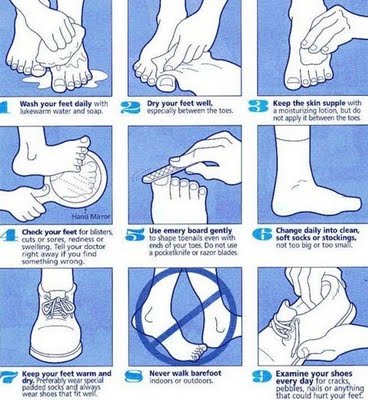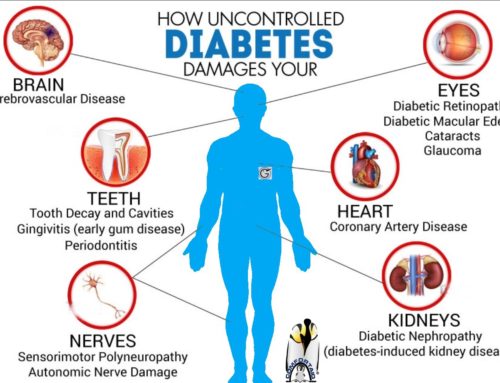There are many things you can do to keep your feet healthy. Regular inspection of your feet is one of the easiest, least expensive and most effective measure for preventing foot complication. Make checking your feet a daily habit. Having everything you need in one place and setting a fixed time every day to check your feet, makes it easier to follow the foot care routine regularly. Here are a few simple steps you can do to keep your feet healthy:
Assemble a foot Care Kit:
Your foot care kit should contain nail clippers, nail file, pumice stone, emery board, skin lotion, talcum powder and a non-breakable hand mirror.
Perform self-examination of your Feet:
It is important to check your feet every evening for cuts, scratches, sores, red spots, swelling, blisters or infected toe nails.
After washing and drying your feet, sit comfortably on a bed or chair in a well lit room with both legs hanging in front of you. Lifting one foot over the opposite leg will make it easier to look at the bottom. Most important thing is to be thorough. Examine the top, bottom, sides, heels and in between the toes. Do a visual inspection first and then feel with your hands checking for any bumps and temperature changes from one part to the other.
If you have trouble seeing the bottom of your feet due to limited flexibility or belly flab, try using a hand mirror or ask someone else to check them for you.
- Balls of the feet
This area endures the highest pressure when you walk, so calluses and sores are more likely to develop here. Check the surface for bumps and irregular texture. - Heels
Check for dry or cracked skin. - Toes
Make sure your toenails are unpolished before your examine them. Spread your toes apart with your fingers and look between them carefully. Check for reddened skin along the side which is a sign of ingrown toenails. Check for the color of your nails Check blood flow by gently squeezing the balls of your toes. Normal color should return in 3-5 seconds.
Adopt a Foot Care Routine:
- Wash your feet every day in warm (not hot), soapy water. Do not soak your feet (more than 5 min) as they can become dry, scaly and cracked causing infection.
- Be sure to dry your feet well. Use a patting or blotting rather than a rubbing motion. Rubbing can damage your skin. Be careful to dry between your toes and use talcum powder or corn starch to keep the skin between your toes dry.
- Moisturize your feet daily. Apply lotion to the top and bottom of your feet to keep them soft. Pay special attention to the heel as it can become dry and cracked. Do not apply between the toes as this can cause the area to become too moist and soggy which can cause the skin to breakdown leading to infection. Wipe off excess lotion and allow your feet to dry before putting on socks.
- Before bathing or showering, test to make sure water is not too hot by using a thermometer or your elbow. If you use a thermometer, less than 95 degree Fahrenheit or less than 35 degree Celsius is safe. Water that is too hot can damage the skin and you might get nasty burns without realizing it.
- Gently rub pumice stone/emery board on corns and calluses after washing your feet. Move it only in one direction. Put a lotion right after you use a pumice stone. It is important to talk to your healthcare provider and let them cut your calluses. Never try to trim them yourself. Do not use corn plasters (as they contain acids and can cause burns), corn and callus removers or blades/sharp instruments, as these may lead to infections.
- Trim your toe nails straight across following the shape of your toes once a week or when needed. Smooth sharp edges with an emery boards or nail file. It is better to trim them when they are soft after washing. If you have poor vision and cannot see clearly, have your podiatrist or another person trim them for you.
Note:
Diabetes and Foot Care … read more:
- Diabetes and Alcohol Consumption – Latest Release







Leave A Comment